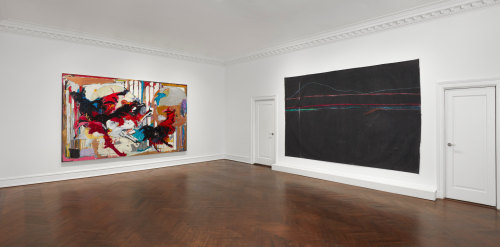
By Jan Avgikos
Though the seventy-eight-year-old Mary Lovelace O’Neal’s art and achievements warrant great acclaim, she is, unfortunately, little known. It’s no small wonder: O’Neal is a black woman based on the West Coast. She was not celebrated in the much touted “Soul of a Nation: Art in the Age of Black Power,” which originated at London’s Tate Modern in 2017 and traveled around the world. “Chasing Down the Image,” a mini retrospective covering five decades of her paintings at Mnuchin Gallery—O’Neal’s first show in New York since 1993—aimed to remedy that omission.
Hailing from Jackson, Mississippi, O’Neal moved to New York in 1968 with a BFA from Washington, DC’s Howard University, following a residency at the Skowhegan School of Painting and Sculpture in Maine; additionally, she also had a track record as a civil rights activist. She graduated in 1969 as the only African American student in Columbia University’s MFA program and the next year moved to Oakland, California, where she has lived since. She blazed a trail with abstract paintings that were as informed by midcentury modernism as they were by experimental black aesthetics, in 1979 becoming the first African American artist to receive tenure in the art department at the University of California, Berkeley. Though black male artists of the time were systematically excluded from roll calls of importance, they ranked above women of color, whose struggles for inclusion were even greater. O’Neal’s dilemma was compounded by the polemics surrounding abstraction: She courageously refused the mandate of the Black Arts Movement and the Black Panthers to produce figurative work that would be accessible to her community and speak to its marginalization. Abstraction, deemed “white man’s art,” was definitely not part of that order. O’Neal saw it differently.
Two exceptional paintings here, both from the 1970s, were revelatory in their capacity to deflect content and affect subjectivity. Begun in New York, when the artist was absorbing the influences of Minimalism, The Four Cardinal Points Are Three: North and South belongs to her late ’60s–early ’70s “Lampblack” series of monochromes, which, as she has put it, are about as literally “black” as a painting can be. Deepest ebony pigment, rubbed into the raw expanse of this unstretched, twelve-foot-wide canvas, has the power to absorb and silence the noise of ideology, activate space, and impact the body. Scant streaks of pastel graze the matte surface, complemented by swirling thin ribbons of darkened masking tape. The work’s radiant counterpart, the equally monumental and nearly monochromatic Steam Engine, shimmers with luminous silver paint that delicately fades out along its frayed edges. Emerging from the upper-left edge of the canvas is a short set of horizontal red bars, which gently disrupt the dreamy modulations of the work’s surface. Gridded by fold lines, flattened out, and nailed to the wall, Steam Engine appeared at once spectacular and fragile, a hierarchical form handled as casually as a household textile or utility tarp.
In the ’80s, O’Neal found her way to a highly energetic expressionistic style of abstraction in which sweeping gestures are choreographed alongside lyrical forms that appear to leap or fly through clouds of color, patterned passages of brushwork, and fields of mixed-media ornamentation. Toni’s Rose Petals (from the “Whales Fucking” series, 1979–early ’80s), 1981, and Running with My Black Panthers and White Doves a.k.a. Running with My Daemons (from the “Panthers in My Father’s Palace” series, 1984–90), ca. 1989–90, reveal an exuberance that borders on delirium. O’Neal, never one to shy away from flamboyance, amps up decorative effects: Before we know it, we’re making connections with a range of black artists, including the likes of Howardena Pindell (one of O’Neal’s contemporaries) and Chris Ofili, who absorbed the Maximalist aesthetics of George Clinton’s Parliament-Funkadelic.
The works also show layers of influence from her world travels throughout North and West Africa, apparent here in vestiges of Moorish arches in She Is Living in the Clouds and Nemesio’s Black Showers, both ca. early 2000s. Allusions to exotic and mysterious places, darkened interiors, and twilight views glimpsed through windows abound in works of this period and brim with suggestive potential. O’Neal’s art is important on many fronts, not least because it insists on the aesthetic integration of experiences and styles once construed to be mutually exclusive.